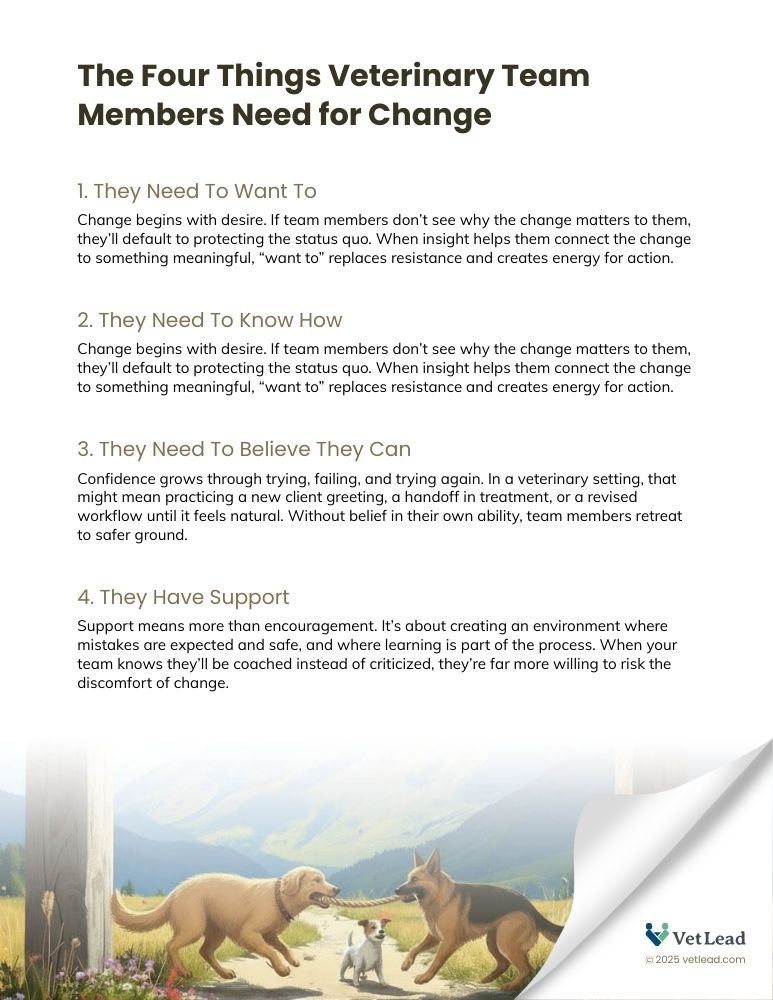Anytime we introduce change into anyone else’s world, stress occurs because they weren’t expecting it.
If you’ve ever rolled out a new protocol in your practice and watched the eye rolls, the whispered frustrations, or the subtle resistance, you’re not alone. Change in veterinary medicine is never just about systems or policies. It’s about people. And people resist change for reasons that are far more human than they are logical.
The good news is, once you understand why resistance happens, you can lead change in a way that lowers stress, builds ownership, and helps your team move forward together.
Why Resistance Happens in the First Place
Our brains are wired for survival, not success. That means we instinctively cling to what feels safe and familiar, even when a new idea could clearly make things better. In a veterinary practice, this shows up when you ask a technician to chart differently, adjust the way appointments are scheduled, or try a new client communication protocol.
Even small changes can feel like big threats because:
- Homeostasis feels safe. If yesterday’s routine didn’t kill us, the brain assumes repeating it today will keep us safe too.
- Expectations drive stress. When something happens we didn’t see coming—like being told a process is changing—our stress rises immediately.
- Habits are automatic. We brush our teeth the same way, tie our shoes in the same order, and follow the same morning routine. Any disruption feels unsafe.
- Thoughts feel like facts. If I believe a new change will be painful or make me fail, that belief alone can stop me from trying.
Resistance isn’t laziness. It’s human biology at work. Recognizing this is the first step to leading through it with patience and clarity.
The Four Things Veterinary Team Members Need for Change
People don’t resist every kind of change. Think about the excitement of getting a new phone. It can mean hours of setting up apps and passwords, but we embrace it because it feels like something we want.
The same is true for your veterinary team. When change works, four things are always in place:
- They want to. Change starts with desire. Without “want to,” nothing else matters.
- They know how. As soon as someone wants to, the brain begins to figure out how. But clear steps still help.
- They believe they can. Confidence grows through trying, failing, and trying again.
- They have support. Without an environment that allows practice and mistakes, people won’t risk moving forward.
When one of these four elements is missing, resistance grows. Your job as a leader is to make sure all four are present.

4 Things Your Team Members Need for Change
Download this free resource, share it with leaders and teams. No email address required.
Stop Chasing, Start Inspiring
Too often, leaders approach change like a tiger chasing its cubs around. We use authority, rules, and consequences to force compliance. Sure, we may get short-term results. But we trade change for engagement.
When people feel forced, they aren’t thinking about the next client or patient. They’re thinking about how unfair or frustrating the change feels. Compliance without engagement doesn’t get you the outcome you want.
Instead, shift from pushing people away from failure to pulling them toward a shared vision of success. Show them how the change could make their workday easier, patient care better, or the team stronger. Help them see what they could move toward, not just what they should avoid.
Use a Process That Builds Commitment
Sustainable change isn’t about one announcement or one training. It’s a process. Here’s a simple path to follow:
1. Create Insight
Ask questions that spark new thinking. “What if we tried it this way?” or “How might this make client visits smoother?” Insight creates the first spark of want to.
2. Involve the Team
Don’t just hand down a decision. Invite input and discussion about what the change could look like in practice. Involvement turns someone else’s idea into our idea.
3. Practice Together
Remember, humans are bad at everything before they’re good at it. Give your team safe ways to try, fail, and improve. Whether it’s running through a new client greeting or practicing a new handoff in treatment, repetition builds confidence.
4. Provide Ongoing Support
Support isn’t just encouragement. It’s creating an environment where mistakes are expected as part of learning. It’s asking, “What did you learn this week?” instead of, “Why didn’t you get it right the first time?”
Move From Resistance to Engagement
When you recognize that resistance is natural, you can stop fighting against it and start leading through it. Change happens when your team sees a path forward that feels safe, possible, and worth pursuing.
This week, think about a change you’ve been struggling to make stick in your practice. Ask yourself:
- Do my team members want to make this change?
- Do they know how?
- Do they believe they can?
- Do they feel supported?
If any of those are missing, that’s where you start. Fill the gap, and you’ll begin to see resistance shift into engagement that has momentum.
One Small Step You Can Take Today
Pick one upcoming change, big or small, and instead of announcing it, ask your team a question that sparks their insight. Listen before you explain. Let them begin the “want to” process themselves.
That single step could be the difference between pushing your team into resistance and helping them move willingly into a better future.
What do you think? Other veterinary pros want to hear from you! Share your experience in the comments below.